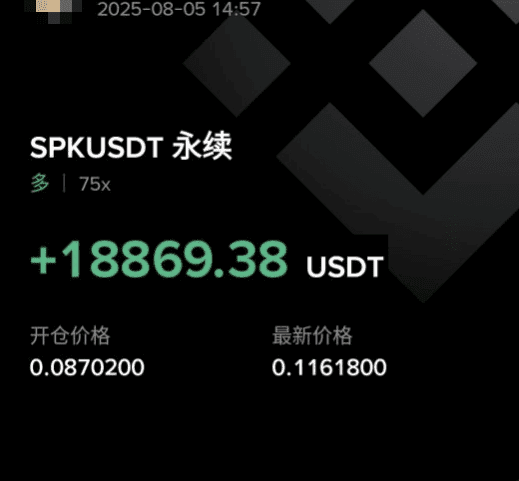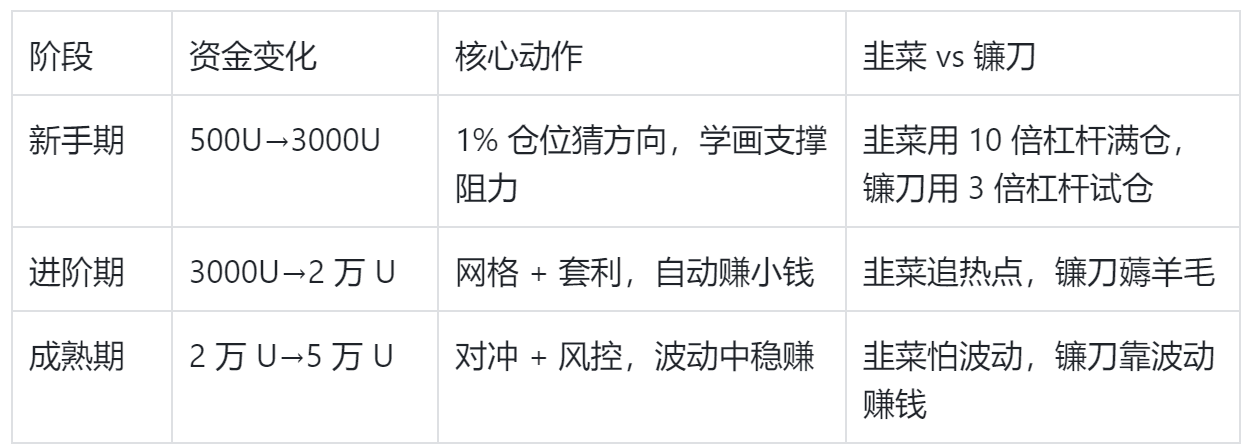A fan named Ahao messaged him yesterday: 'Bro, I finally dare to say I understand contracts—last week I earned 3000U using grid trading without monitoring and didn’t get liquidated.' Six months ago, he was a complete novice: guessing price movements based on feelings, using 10 times leverage to go all-in, and getting liquidated twice in 3 days without knowing what funding rates were.
The transition from novice to expert is not due to a sudden epiphany, but through thoroughly understanding the three 'coins' of contracts: the underlying logic of directional bets, advanced strategies for combination, and the life-and-death lines of risk control. These three tactics seem simple but can help you avoid 80% of the liquidation traps—Ahao used them to roll from 500U to 50,000U, and today he will break it down for you so you can get started after reading.

The first coin: the underlying logic of directional bets—don’t treat dice like coins.
When Ahao first started trading contracts, he thought 'going long means betting on price rises, while going short means betting on price drops.' As a result, he treated 10 times leverage like rolling dice, with wins or losses solely based on luck. Later, he realized that the essence of contracts is a 'probability game,' not 'betting size,' and learning to calculate win rates is more important than guessing price movements.
① Before betting, draw the 'life-and-death line': determine direction using support and resistance.
Now before Ahao opens a position, he must draw two lines on the candlestick chart:
Support level (the back of the coin): the price that has not broken down in the last 3 attempts, such as BTC at 116,000.
Resistance level (the front of the coin): the price that has failed to rise over the past 3 attempts, such as BTC at 120,000.
When the price breaks the resistance level, he goes long; if it falls below the support level, he goes short. He resolutely doesn’t act during sideways movements. This tactic has raised his win rate from 30% to 65%—last year, when ETH broke the 2700 resistance level, he went long and earned 1200U; when it fell below the 2500 support level, he shorted and earned another 800U, profiting from both sides.
② Leverage is not a 'magnifier,' but an 'accelerator.'
10 times leverage doesn’t mean you earn 10 times; it means 'using 1U to earn the opportunity for 10U.' Ahao calculated a sum:
With 1000U capital, opening a position with 10 times leverage means actually using 10,000U.
A 1% rise earns 100U (equivalent to 10% of capital); a 1% drop loses 100U.
But including transaction fees and funding fees, it actually needs to rise by 1.5% to break even.
So now he only uses 3-5 times leverage. Although it earns slowly, the win rate is higher. Once, a fan named Lao Zhou laughed at him for being 'cowardly' and used 10 times leverage to go all-in, resulting in a liquidation after a 5% pullback, while Ahao with 5 times leverage held on and ended up making a profit of 300U.
③ Don’t guess 'which side is up'; wait for 'the coin to land' before placing your bet.
The dumbest thing is to open positions during sideways movements. For example, when BTC fluctuates between 100,000 and 110,000, Ahao used to always guess the direction and ended up losing on 4 out of 5 trades. Now he waits for 'the coin to land'—if it breaks 110,000, he goes long; if it breaks 100,000, he goes short. Although he earns 10% less, he avoids 80% of the choppy traps.
"I used to think waiting for a breakout would make me miss opportunities, but now I understand that missing is better than making a mistake." In Ahao's delivery orders, 30% of the time is in cash, but the profit is twice what it was before.
The second coin: advanced play of strategy combinations—let the market 'give you money.'
Those who guess market trends are novices; those who use strategy combinations are experts. Ahao now uses three 'automated profit' strategies, allowing him to earn steadily even with less monitoring:
① Grid trading: the 'ATM' in a choppy market.
Last year, BTC consolidated between 90,000 and 105,000 for 20 days, and Ahao set up a grid:
Automatically buy 100U for every 500U drop (for example, buy 100U at 90,000, then 100U again at 89,500).
Automatically sell 100U for every 500U rise (for example, sell 100U at 105,500, then sell another 100U at 106,000).
In 20 days, he automatically bought low and sold high, earning 2300U, more than when he operated manually. The core of grid trading is that the greater the volatility, the more you earn, but remember: if the sideways range is less than 3%, don’t use it, as transaction fees will eat into profits.
② Funding fee arbitrage: zero-risk 'shearing sheep.'
Ahao discovered a secret: when the funding fee for contracts is very high (for example, >0.15%), you can open positions simultaneously:
Buy 1000U of ETH in the spot market (going long).
Open a 1000U ETH short position (short selling) in the contract market.
This way, regardless of whether the market goes up or down, you can earn funding fees (when longs pay shorts, shorts earn the rate; vice versa applies). Last year, he made a guaranteed profit of 500-800U per month using this method, zero risk, suitable for beginners to practice.
③ Hedging strategy: the greater the volatility, the more you earn.
Previously, when FTX collapsed, the market was in chaos, but Ahao earned 12,000U, relying on hedging:
Open a 5000U BTC long position (afraid of a surge).
Simultaneously open a 5000U BTC short position (afraid of a crash).
Set stop losses properly; close profitable positions on the winning side.
As a result, BTC fell first and then rose; he closed his short position earning 6000U, and then closed his long position earning another 6000U—the greater the volatility, the more you earn. This tactic is suitable for black swan events, allowing you to stay calm amidst chaos.
The third coin: the life-and-death line of risk control—survival is essential to earn money.
After being liquidated twice, Ahao finally understood: the key to making money in contracts is not about how good you are, but about survival. These three life-and-death lines, he now engraves on his phone case:
① Position = lifeline: open positions with 1% capital; even if wrong 100 times, you won't die.
With a capital of 50,000U, using only 500U (1%) for each trade, 3 times leverage, and a stop loss of 5%—even if wrong 20 times in a row, you only lose 5,000U, leaving 45,000U. Ahao has seen too many people open positions with 50% margin, losing everything with one wrong trade. '1% margin may be slow, but it allows you to survive.'
② Stop loss = brakes: 'write the will' when opening a position.
Now he always sets a stop loss when opening a position; for example, if he goes long ETH to 2000U, he sets the stop loss at 1900U (a 5% drop), automatically closing at the target without holding a losing position. Once, he manually turned off the stop loss, thinking 'just wait a bit longer,' and ended up losing 3000U; since then, he has never dared to touch the stop loss button again.
③ Emotions = the devil: if you have three consecutive stop losses, force yourself to stay out of the market for three days.
Ahao has an alarm that goes off after 3 consecutive stop losses; when it rings, he closes the software and goes out for a run or a movie, and he doesn’t touch contracts within 3 days. This tactic has helped him avoid 6 instances of emotional averaging down, saving him at least 20,000U.
There are also two iron laws that beginners must engrave in their hearts:
Keep 12 months of living expenses: Ahao divides his 50,000U into two parts, 30,000U for trading, and 20,000U in the bank for living expenses; even if he loses in trading, it won't affect his meals.
Don’t believe in 'sacred indicators': turn off KDJ and MACD, only look at support, resistance, and trading volume. 'Indicators are for novices; experts only look at the flow of real money.'
The 3 stages from novice to expert: Ahao's practical notes.
He completed these three steps in half a year, and now he steadily earns 10%-15% every month:

Finally, a piece of advice for beginners: trading contracts is not a gambling table; it's a battlefield. Novices swing their knives randomly, while experts attack with shields—how long you can survive depends not on how good your knife skills are, but on how strong your shield is.
Starting next week, I'll guide practice on the 'grid trading + funding fee arbitrage' combination, beginning with small guaranteed profits, setting up according to the chart, and making money passively in a volatile market. If you also want to learn, feel free to follow @bit多多 . Remember: Ahao could rise from 500U, not because he is smart, but because he learned 'not to get liquidated'—these three words are worth 100 lessons from liquidation.
The ultimate secret of contracts is not predicting price movements, but letting profits run while stopping risks. Mastering this tactic will bring you closer to expertise.




